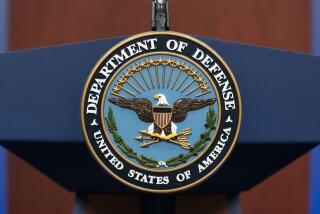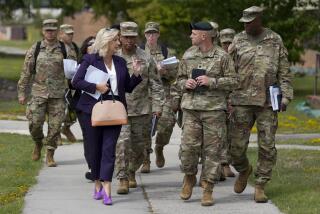War-Weary Air Force Weighs Need to Expand
- Share via
WASHINGTON — Air Force officials, concerned about the strains evident during the Kosovo air war, are gingerly considering whether they need to expand their active-duty force after a decade of post-Cold War downsizing.
Busier than any other U.S. military service in the 11-week campaign, the Air Force assigned 25,000 personnel to the European theater and deployed a higher share of its combat planes worldwide than were used in either the Persian Gulf War or the Vietnam War.
About 44% of combat-ready fighter aircraft were engaged worldwide during the Kosovo conflict, compared with 41% in the Persian Gulf War and 36% in December 1969, during the height of the Vietnam War, officials said.
One senior Air Force official, who insisted on remaining unidentified, said the leadership is “looking at the implications” of the high use rate, both in terms of future needs for certain planes and “in terms of the total number of people.”
The Air Force has shrunk from about 600,000 active-duty personnel at the end of the Cold War to about 370,000 today.
Some officials of the Army, Navy and Marine Corps have raised similar questions recently about the need to increase their active-duty forces in light of the numerous--and often lengthy--overseas missions undertaken during the last decade.
But some analysts predicted that proposals to start increasing military forces may not be well received in Congress, where lawmakers are entangled in bitter disputes over whether to use the budget surplus on domestic programs or tax cuts.
With the 2000 elections in view, lawmakers may now “give it lip service,” said Michael O’Hanlon, a defense analyst at the Brookings Institution, a centrist think tank in Washington. But over the long term it will become clear, he predicted, that “the money just ain’t there.”
The Air Force leadership has felt the need for additional personnel as it has sought to organize a new system of 10 “air expeditionary forces” for overseas contingencies. The system is intended to provide for a more orderly rotation of forces and to more evenly distribute the burden of deployments that disrupts family lives and training routines.
But officials said they have discovered they would need several thousand additional personnel to make the system work without overloading airmen in some jobs in the United States. They also acknowledged they may be able to meet their needs without expanding the force, either by further shrinking the headquarters staff or by turning to contractors for some work.
In any case, they said the Kosovo campaign has clearly strained both personnel and aircraft.
Air Force officials noted that the air campaign came only three months after Operation Desert Fox, the four-day bombardment of Iraq in December. These two deployments together have pulled airmen away from planned training and made it difficult to return them to their rotations.
Officials of the Air Combat Command, which supplies warplanes to overseas commanders, have estimated that the Kosovo conflict increased the Air Force’s “stressed job specialties,” those in which personnel are overseas at least 20% of the time, from 21 to 62.
The Air Force will need about six months to recuperate from the disruptions caused by Kosovo, the senior official said.
Even so, the disruption will mean that some positions in the new air expeditionary force units will be initially unfilled, officials said.
“There was a toll taken on our people. It’s pretty significant,” said the Air Force official. “This was a major theater war for us.”
The strains of the conflict came at a time when the Air Force had been struggling to hold on to pilots and senior ground crew personnel who have been lured away by a fast-growing airline industry.
And recruitment has lagged.
Only last week, the Air Force acknowledged that it would fall 2,500 recruits short of its goal of 33,800 airmen for the fiscal year that ends Sept. 30. It would be the first such shortfall since 1979.
In hopes of ending a prolonged recruiting slump, the Air Force is beginning its first paid television ad campaign, an 18-month, $54-million effort that begins Monday and will run through September 2000.
More to Read
Sign up for Essential California
The most important California stories and recommendations in your inbox every morning.
You may occasionally receive promotional content from the Los Angeles Times.














